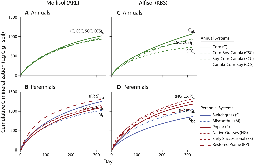Early accumulation of active fraction soil carbon in newly established cellulosic biofuel systems
We examined relative changes in soil C pools shortly after the establishment of six perennial and two annual bioenergy cropping systems that differed in diversity (monoculture vs. polyculture). Perennial systems included two monocultures (switchgrass, Panicum virgatum; and miscanthus, Miscanthus × giganteus) and four polycultures including hybrid poplar (Populus sp.) + herbaceous understory; mixed native grasses, successional vegetation, and restored prairie. Two annual systems included no-till continuous corn (Zea mays) and rotational corn (corn-soybean (Glycine max)-canola (Brassica napus)). Each crop was planted in a full factorial design at both a moderate fertility Alfisol and a high fertility Mollisol site. Relative differences in active, slow, and passive C pools in surface soils, where C changes are most likely to be detected early, were evaluated with 322-day laboratory incubations followed by acid hydrolysis to infer different pools from exponential decay curves. Five years post-establishment, active C pools under perennial polycultures at the Alfisol site were up to twice those under annual and perennial monocultures, and followed the order hybrid poplars (696 ± 216 μg C g-1 soil, n = 5 replicate blocks) ≈ native grasses (656 ± 155) ≈ restored prairie (638 ± 44) > early successional (500 ± 54) ≫ continuous corn (237 ± 68) ≈ rotational corn (180 ± n.a.). Active C pools in perennial monocultures were similar to those in continuous corn: switchgrass (274 ± 29) ≈ miscanthus (299 ± 9). In contrast, differences in active C pools among crops at the more fertile Mollisol site were not detectable except for greater pools in the restored prairie and rotational corn systems. At both sites, slow and passive C pools differed little among systems except that slow pools were greater in the poplar system. That diversity rather than perenniality itself led to greater active C pools suggests that polycultures might be used to accelerate soil C accumulation in bioenergy and other perennial cropping systems.
- Research Organization:
- Univ. of Wisconsin, Madison, WI (United States)
- Sponsoring Organization:
- USDOE Office of Science (SC)
- Grant/Contract Number:
- FCO2-07ER64494; FC02-07ER64494
- OSTI ID:
- 1631763
- Alternate ID(s):
- OSTI ID: 1506648
- Journal Information:
- Geoderma, Journal Name: Geoderma Vol. 318 Journal Issue: C; ISSN 0016-7061
- Publisher:
- ElsevierCopyright Statement
- Country of Publication:
- Netherlands
- Language:
- English
Web of Science
Similar Records
Data from: Nitrous oxide emissions during establishment of eight alternative cellulosic bioenergy cropping systems in the North Central United States
Nitrous oxide emissions during establishment of eight alternative cellulosic bioenergy cropping systems in the North Central United States





